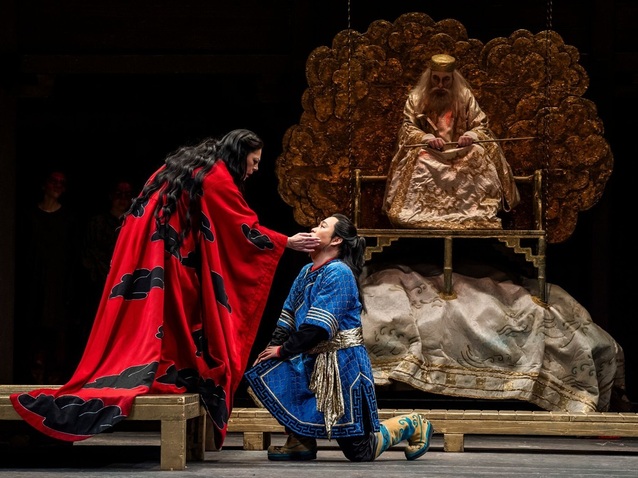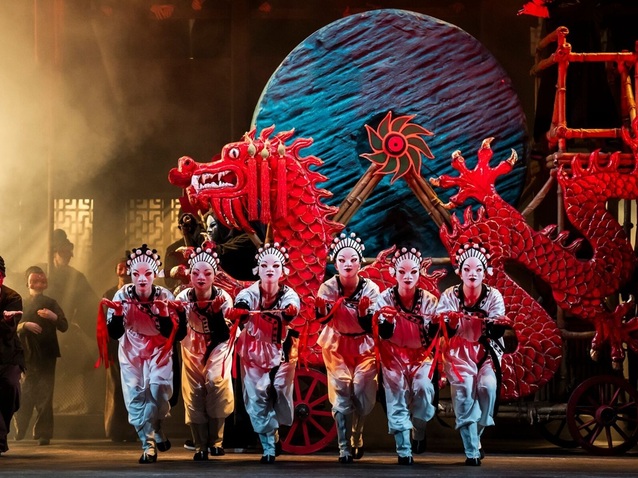 © Tristram Kenton
© Tristram Kenton
Turandot, with a libretto by Giuseppe Adami and Renato Simoni, is Giacomo Puccini’s final opera. It was left unfinished at the time of his death in 1924, and posthumously completed by Franco Alfano before premiering at Milan’s Teatro alla Scala in 1926. There have subsequently been other completions of the score, most notably by Luciano Berio in 2001, but the Alfano version remains the most frequently performed, and is the one used in this instance.
Set in Peking in legendary times, it sees Calàf, son of the deposed King of Tartary Timur, fall in love with Princess Turandot, daughter of the Emperor Altoum. He becomes infatuated the moment he sees her, but the only way to win her hand is to answer three riddles correctly, with the penalty for failure being death. Many have tried and not one has survived, leading Timur, his slave girl Liù, and the Emperor’s Ministers Ping, Pang and Pong to attempt to dissuade him from pursuing her. Calàf ignores them all and faces Turandot, who explains that she set this challenge to avenge the murder of Princess Lo-u-ling, who now shelters in her spirit, by a man a thousand years ago. Calàf answers all three riddles correctly, but she protests against being given like a slave. While the Emperor asserts that the rules are sacrosanct, Calàf, not wishing to possess Turandot against her will, sets her a new challenge that if she can discover his real name before dawn he will die.
Turandot directs all resources towards seeking out his name, insisting it must be revealed under pain of death. It becomes clear that Liù alone knows it, prompting Turandot to torture her and threaten worse in order to extract it. Liù remains steadfast, but fearing how much she can withstand, stabs herself to ensure she never gives away the secret. Calàf orders Turandot to come down to earth, while she continues to insist she is the daughter of heaven, but when he kisses her she is transformed. Turandot declares she has been defeated, not by the trial but by the fever that now flows from him to her. The opera ends with her proclaiming Calàf’s newly discovered name, which she now knows to be Love, to the crowds.

Sondra Radvanovsky as Princess Turandot, SeokJong Baek as Calaf and Paul Hopwood as Emperor Altoum in Andrei Serban's production of Puccini's Turandot, The Royal Opera ©2025 Tristram Kenton
When John Copley’s 1974 production of La bohème celebrated its 41st birthday, a lot of attention was paid to the fact. Andrei Șerban’s Turandot, which premiered in 1984, has now reached the same age with comparatively little commentary. This may be because 2015 marked the final revival of that La bohème, while there are no signs this Turandot, which is revived on this occasion by Jack Furness, is going anywhere. That is a good thing because, with a production as strong as this, who would ever want to change it? The secret to the staging’s success is that, on the surface, it appears to be quite traditional as bright costumes, masks, wooden structures and Chinese dancing (courtesy of choreographer Kate Flatt) dominate. It proves to be multifaceted, however, by clearly highlighting the full range of horrors that lie beneath the colourful veneer.
Turandot is an unsympathetic character who uses a thousand year old wrong to justify death to numerous people who were never responsible for the original evil. Although we might accept this as part of a set-up that enables her then to undergo a personal transformation, the opera does present a story, and by extension world, in which there is far more cruelty than beauty. Șerban’s staging reflects this by seeing dancers, who are ostensibly there to entertain, mime slitting their throats as a way of premeditating Calàf’s likely fate. Similarly, the fact that Ping, Pang and Pong (an excellent Hansung Yoo, Aled Hall and Michael Gibson) beat Liù with stylised, slow motion gestures means that an incredibly violent act is veiled by being presented in a theatrical manner. When so many opera productions today go all out to reveal just how distasteful the story that is being told is, Șerban hides the reality behind a cloak of ‘respectability’ that, if anything, makes it even more hard hitting.

Andrei Serban's production of Puccini's Turandot, The Royal Opera ©2025
The production is full of telling details. Calàf takes Timur’s staff to strike the gong that signals his acceptance of the challenge, signifying how his decision is removing his father’s means of escaping the situation. Four huge masks on poles overlook the stage, which at first appear decorative or ritualistic as red ribbons stream from their mouths and necks. When the Phantoms of those who died undertaking the challenge sing, however, we realise these are their severed heads, and the ribbons blood. Masks carry significance in other ways, as revealed by the Prince of Persia wearing one as he is led to his death. Does it merely hide the tears and fear that lie behind it, or in its own right describe the passivity of one who is resigned to his fate?
The huge wooden structure that makes up Sally Jacobs’ set, with its latticed windows through which light courtesy of F. Mitchell Dana floods, may typify traditional Chinese architecture. Its greater significance, however, lies in creating an arena for the action that reveals the entirely repressive nature of the situation. The principals’ costumes may be brightly coloured, but the chorus who occupy the surrounding tiers as spectators are dressed in grey and brown. Theatrically this contrast leads our eye towards the action in the centre, but it says an enormous amount about the rights and status of the ordinary city dwellers.
The production also ensures that the emotional colour wheel is constantly kept turning. When Ping, Pang and Pong try to dissuade Calàf from taking up the challenge, the stage is filled with colour and movement. When we then move to Timur and Liù attempting to do the same, everyone else is removed from the central space so that the atmosphere becomes more intimate and serious. When the whetstone on which the sword that is to execute the Prince of Persia is wheeled on, dancers perch on the structure so that the mood is almost carnivalesque. After the Prince is seen, however, the crowd realise the true horror of the situation, so that the feeling surrounding his death is one of collective sorrow.

Anna Princeva as Liù and Adam Palka as Timur in Andrei Serban's production of Puccini's Turandot, The Royal Opera ©2025 Tristram Kenton
The principals are superb, and the fact there is not a weak link among them helps to make the evening feel special. SeokJong Baek is an extremely persuasive Calàf, with his tenor being as secure as it is expansive so that there is never any sense that it will waver for a moment as he espouses his most emotive lines. Sondra Radvanovsky perfectly captures Turandot’s icy allure, with the strength and vibrancy in her voice ensuring that it pierces the heart just as much as it chills the bones. She also proves a fine actor as her gestures and expressions reveal this proud figure’s fear every time that Calàf comes one step closer to possessing her.
Anna Princeva as Liù reveals an immensely sensitive soprano, and makes parts of ‘Signore, ascolta’ so hushed that we feel her emotion as a single strain of sound passing tentatively through the air. Adam Palka with his resonant bass is a dignified and highly human Timur, while there is splendid support from Paul Hopwood as Emperor Altoum and Ossian Huskinson as the Mandarin. Rafael Payare conducts with a sense of purpose, while being highly attuned to the disparate demands of the score and the contrasts that these are designed to elicit.
Amidst the final rejoicing Timur leads the chariot carrying the body of Liù across the stage. As we see the expression on Palka’s face we know that Timur’s love for Liù is not the same as Calàf’s for Turandot or Liu’s for Calàf, for which no price is too high to pay. Rather it is the deep affection that a master would have for a servant who had been so loyal, and consequently feels extremely human. Turandot herself sheds a tear as she gazes on the scene, although the fact that both she and Calàf forget their sorrow so easily as they embrace once more leaves a bitter taste in the mouth. This, however, is revealing of the production’s ability to inspire so many different emotions in us, and it consequently deserves to last for decades more.
Several roles are shared between two performers across the run, while Francesco Ivan Ciampa conducts on 12, 15 and 19 April. This production, featuring the cast and conductor described above, will be broadcast live to selected cinemas around the world on 1 April, with some venues also showing encore screenings on subsequent days.
By Sam Smith
Turandot | 19 March - 19 April 2025 | Royal Ballet and Opera, Covent Garden
the 26 of March, 2025 | Print
Comments